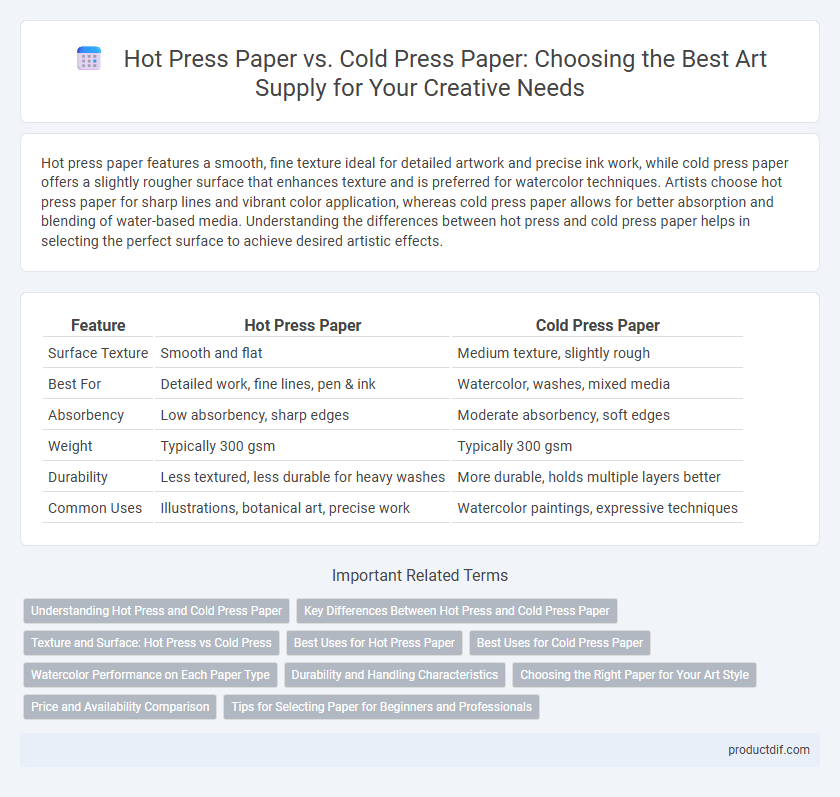Hot press paper features a smooth, fine texture ideal for detailed artwork and precise ink work, while cold press paper offers a slightly rougher surface that enhances texture and is preferred for watercolor techniques. Artists choose hot press paper for sharp lines and vibrant color application, whereas cold press paper allows for better absorption and blending of water-based media. Understanding the differences between hot press and cold press paper helps in selecting the perfect surface to achieve desired artistic effects.
Table of Comparison
| Feature | Hot Press Paper | Cold Press Paper |
|---|---|---|
| Surface Texture | Smooth and flat | Medium texture, slightly rough |
| Best For | Detailed work, fine lines, pen & ink | Watercolor, washes, mixed media |
| Absorbency | Low absorbency, sharp edges | Moderate absorbency, soft edges |
| Weight | Typically 300 gsm | Typically 300 gsm |
| Durability | Less textured, less durable for heavy washes | More durable, holds multiple layers better |
| Common Uses | Illustrations, botanical art, precise work | Watercolor paintings, expressive techniques |
Understanding Hot Press and Cold Press Paper
Hot press paper features a smooth, fine surface ideal for detailed artwork, providing crisp lines and minimal texture interference. Cold press paper offers a slightly rough texture that enhances watercolor techniques by allowing better pigment absorption and subtle texture effects. Artists choose hot press for precision and cold press for expressive, textured washes.
Key Differences Between Hot Press and Cold Press Paper
Hot press paper features a smooth, fine surface ideal for detailed work, offering minimal texture that enhances precision in watercolor and ink applications. Cold press paper has a slightly textured, rough surface which provides better absorption and creates natural, varied effects suited for washes and layering techniques. The key differences lie in surface texture, absorption rate, and suitability for different painting styles, with hot press paper favoring detail and cold press facilitating texture and blending.
Texture and Surface: Hot Press vs Cold Press
Hot press paper features a smooth, fine texture ideal for detailed work and sharp lines, making it perfect for precise watercolor techniques and pen-and-ink drawings. Cold press paper has a slightly textured, moderately rough surface that enhances the granulation of watercolor pigments and provides a natural, tactile feel suited for expressive brushstrokes. Artists often choose hot press for intricate detail and cold press for textured, organic effects in their artwork.
Best Uses for Hot Press Paper
Hot press paper features a smooth surface ideal for detailed and intricate artwork, making it a preferred choice for fine line drawing, watercolor painting with precise control, and mixed media applications. Its even texture allows for crisp color application and blending, especially suited for botanical illustrations, architectural sketches, and portraits. Artists seeking high-definition detail and vibrant color saturation often select hot press paper for professional-quality results.
Best Uses for Cold Press Paper
Cold press paper offers a moderately textured surface ideal for watercolor artists seeking controlled washes and detailed work. Its absorbent nature allows for gradual color blending and layering, making it best suited for techniques requiring precision and subtle texture. This paper type excels in rendering botanical illustrations, portraits, and fine art that demand enhanced paint retention and depth.
Watercolor Performance on Each Paper Type
Hot press paper features a smooth, non-textured surface that allows watercolor pigments to sit on top, offering crisp detail and vibrant color intensity ideal for fine line work and detailed washes. Cold press paper, with its moderately textured surface, enhances pigment absorption and water retention, producing softer edges and rich granulation effects perfect for expressive, fluid watercolor techniques. Artists often choose cold press for dynamic washes and hot press for precision, making paper texture a crucial factor in watercolor performance.
Durability and Handling Characteristics
Hot press paper features a smooth surface that allows for fine detail and crisp lines, making it ideal for precise watercolor and ink work, while its tight fibers contribute to moderate durability. Cold press paper boasts a textured, slightly rough surface that enhances paint absorption and blending, with a thicker composition that generally offers superior durability and resilience against heavy washes. Artists handling hot press surfaces benefit from controlled brush strokes, whereas cold press surfaces provide better grip and variability, accommodating diverse wet and dry media techniques.
Choosing the Right Paper for Your Art Style
Hot press paper features a smooth, even surface ideal for detailed, precise work such as illustration and ink drawing, while cold press paper offers a textured finish perfect for watercolor and mixed media that require color absorption and layering. Artists seeking fine lines and sharp details often prefer hot press, whereas those emphasizing texture and blending tend to choose cold press. Matching the paper type to your preferred medium and technique ensures optimal control and artistic expression.
Price and Availability Comparison
Hot press paper generally costs more than cold press paper due to its smooth surface and higher production quality, making it preferred for detailed artwork and fine lines. Cold press paper is widely available and more affordable, favored by watercolor artists for its textured surface that holds pigment effectively. Both types are readily accessible at most art supply stores, but cold press maintains greater availability in budget-friendly options.
Tips for Selecting Paper for Beginners and Professionals
Hot press paper offers a smooth, fine surface ideal for detailed work and precise lines, making it perfect for beginners seeking clean results. Cold press paper features a textured surface that enhances tonal variation and brush control, preferred by professionals for expressive techniques and layering. When selecting paper, beginners should consider the type of medium used and desired finish, while professionals may prioritize paper weight, absorbency, and durability for complex projects.
Hot Press Paper vs Cold Press Paper Infographic

 productdif.com
productdif.com